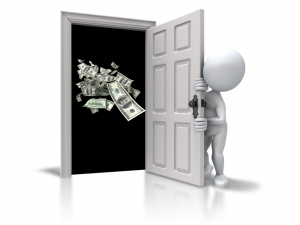Yardsales.com Donates 20% Proceeds to The Hayden Riley Ritchie Leukemia Trust
Simply click on the play button below to watch the video.
Posted in Yard Sales by .
Jun 11
17
A Fortune In Old Post Cards!
Featured Guest Blog by Ed Augusts
 I didn’t think a fortune could be made in nothing more than old post cards until I bumped into an old fellow who had a couple of boxes of ’em at a garage sale one morning. It was late spring verging on summer and warm already at nine o’clock, and there must have been a game on, because it was quiet enough that I didn’t feel rushed. I couldn’t help noticing his nice collection of old postcards and asked him if he’d be interested in selling ALL OF THEM in one batch. “Oh, I’d have to think about that!” he said. I gave him my card.
I didn’t think a fortune could be made in nothing more than old post cards until I bumped into an old fellow who had a couple of boxes of ’em at a garage sale one morning. It was late spring verging on summer and warm already at nine o’clock, and there must have been a game on, because it was quiet enough that I didn’t feel rushed. I couldn’t help noticing his nice collection of old postcards and asked him if he’d be interested in selling ALL OF THEM in one batch. “Oh, I’d have to think about that!” he said. I gave him my card.
About a month later, a lawyer visited my store. This was back in 1989 or so. He said he was representing an elderly male client who had a large collection of old post cards on her hands! I had mentioned that I might be interested in buying ALL his post cards… How much would I pay for them?
I said I’d have to have a look at the whole batch, I’d seen a couple of boxes, but I’d be interested in seeing anything he could bring me. I apologized for the fact that, postcards weren’t my specialty any more than comic books or ephemera, but I wouldn’t mind having a few boxes of postcards for browsers to have a look at when they visit. He said he’d bring them by.
A few days later, he returned. There were more than six thousand picture postcards that had been stamped and mailed between about 1895 and 1920; there was literally nothing after 1920. There were a couple of albums of special stamps, such as one that showed English stage actresses from the turn-of-the-century. I wasn’t very excited about them when I first saw a couple of boxes at the garage sale, but now that I saw about five times that many, I was just about floored! I felt differently. I knew from previous visits to post card tables at Stamp and Coin shows that picture postcards could be valuable. Then again — these could have been duds! What was I SAFE in spending? Maybe a dime each, huh? How could I go wrong at a price like that?
“As I said, this isn’t my specialty, and I just know if these have much value. So the best I can do is $600.” He looked me in the eye. “Is that a serious offer?” he asked. “That’s the best offer I can make.” He immediately got on his mobile phone, speaking quietly to the old gent who was the purported purveyor of this lot. He smiled for the first time. “He says that’s fine!” So I made out the check for $600 and he piled up the long, narrow boxes of postcards on my desk and left.
I immediately got to thinking whether I’d overpaid. 10 cents apiece added up fast when there are 6,000 items. I was “in” over my head, that was for sure, and wondered if I’d soon regret the fool’s bargain I had made.
I bet the guy who bought the Stradivarius for ten bucks felt like maybe he’d been ripped-off, too!
Now came a bit of a chore, but a delightful task if you love geography, travel, and history! If not, this may not be the business for you! There were dozens and in some cases hundreds of cards about various railroad lines, trains, and railroad stations, even little whistle-stops that had long ceased to exist on railroad lines that were also gone. There were dozens and dozens of different lighthouses, and dozens of different bars, restaurants, car lots, factories, pet food plants, lakes, streams, barns and outhouses, from one end of the continent to the other. The Royal families of several European nations were featured, and some of these were in raised ‘3-D’ effect. There were German and Austrian and Belgian and French and English and Swedish and Italian and Spanish and Portuguese and Danish and Russian and Greek, Cyprian, Turkish, Palestinian, and South African postcards, all bearing stamps from those countries. Scenes of soldiers going off to war, b&w photos of battle ships and cruisers, sentimental old valentines cards and –something not seen too often nowadays – Halloween cards. The Christmas cards were all rather special, they were not ordinary, and they had been chosen for the unique touch! The messages on the back were in various hands, and mostly in English, and some of the tales and anecdotes were quite touching or humorous.
It was a real chore to sort these cards out, because they weren’t sorted when I got ’em. I put two high school girls to work sorting them out after school, as well as Della, my faithful secretary. In the end I was able to start selling postcards. I had two stores at the time, and divided them between both locations.
My success, then, as now, was predicated upon YARD SALES, GARAGE SALES, ESTATE SALES, and MOVING SALES and all the good things that spin-off from these kinds of events! My task, as I saw it, was the convert SUB-WHOLESALE to RETAIL, or close to retail!
People poured & pored over them for hours at a time, and I discovered that I’d gotten a whole new set of customers now – postcard collectors! I got back my investment within a month or two, and then kept selling at least a hundred dollars a week – all profit! — From that time on, and when I left that business to go into another one in a new location, I still had thousands of postcards left.
I took some with me to California and sold just the English stage actress postcards for $1,000 through a private sale arranged by a stamp store in Santa Clara. All in all, it wasn’t the best deal by any means during my years as a bookstore owner, but I still got back at least 10X on my investment. You can too, if you can get a worthwhile collectible at “the right price”-sub-wholesale is what I’m always looking for! –And go through whatever it is you have to do to market it as close to full retail as you can –
Thanks again! —–Ed!
http://www.edaugusts.com/YardSales/
General DirectoryRanking Website Directory
Posted in Yard Sale Finds by .
Jun 11
13
Is There Cash in Your Closet?
Do You Have Clothes You Haven’t Worn in a Really Long Time?
 If you are like most people, you probably have lots of clothes of various styles in various sizes that you wouldn’t even notice if they were gone. And of course, the older we get, the more clothes we have that fall into this category.
If you are like most people, you probably have lots of clothes of various styles in various sizes that you wouldn’t even notice if they were gone. And of course, the older we get, the more clothes we have that fall into this category.
Did you know that you can clean out your closets AND make money at the same time?
Skip McGrath in his article eBay Sellers Find Cash in Their Closets: How to Get Started Selling Your Own Clothes on eBay gives you an introduction to the basics of selling clothing on eBay. Great advice like sorting your clothes by season and size. To read the entire article, click here.
Posted in ebay re-seller Garage Sales by .
Garage Sale Professional, celebrity, and Expert, Bruce Littlefield shares his expert knowledge of how to find hidden treasures at garage sales.
Posted in Garage Sales by .
Featured Guest Blog by Ed Augusts
 Based on a life-long interest in used and rare books, I would like to suggest what kinds of books to avoid. If you are buying? Don’t buy ’em! If you are Selling? Good Luck!
Based on a life-long interest in used and rare books, I would like to suggest what kinds of books to avoid. If you are buying? Don’t buy ’em! If you are Selling? Good Luck!
First, EX-LIBRARY books are a real drag! If they were NEVER RETURNED to the library where they were checked-out, they should be returned, even if years have gone by. Such books were stolen! They should never be bought and sold. If they are legitimate “DISCARDS”, however, such as can be had at a Library Sale, and are often STAMPED as such, they have to be about 80 years old to be worth more than a buck. That’s especially if they are all marked-up. Books that were available for check-out at a public library are generally numbered on the spine, with accession info on the title page, and/or the edges, stamped, and/or with a ‘packet’ in the front or back inside covers, and so on. (But you KNEW all that, right?)
Some libraries treat books more gently than others, however. You may find some that are not disgusting to a collector. Private library holdings — the odd collector who has numbered his books — are not so bad, especially if the collector is of interest, himself. Often such books will have curious bookplates that tell us something about the former owner. I have had books with bookplates by the likes of William Randolph Hearst and several Hollywood celebrities. Bookplates are often works of art, and the fact they were lovingly selected by a bibliophile makes them quite revealing about the person. One handsome bookplate identified an old medical book as having belonged to a man whose name sounded familiar, but I didn’t recognize it. I “Google Searched” and discovered a big medical center had been named for him… Langley Porter! Needless to say the book was worth at least $20.00.
Books that have been in college or ecclesiastical libraries 100+ years ago actually have a certain ‘flavor’ from a few bookplates and a few light stampings, and need not be tossed-out, they may be quite valuable. I had a book in Latin, on vellum with calf covers, by Erasmus of Rotterdam that had been printed in Paris in 1531. The book had been in several monastic and scholarly libraries over the centuries, and the markings inside the covers did not detract from the value in the slightest — in fact, they added interest!
But a big inscription when you open the covers that reads something like: “To Randy on his Fifteenth Birthday from Mom and Dad, with Love,” detracts from value… unless you are a member of that family!
Second, discard Book Club editions from serious consideration. Often, if a person has one book club edition, they will have 500 book club editions, and if you are a buyer — DO NOT load-up on book club editions! The front inside ‘flap’ of a book club dustjacket will clearly say ‘Book Club Edition’. For books of the past 20 years or so, the back of the book and/or the dustjacket will have a series of numbers. If a book is 40 or 50 years old, or older, but does not have a dustjacket, look for a little ‘dimple’ on the lower part of the back cover. The dimple is sometimes round, sometimes square. That is a dead-give-away that it is a Book Club edition. Book club editions are worth only a few bucks, if in dust jackets, and practically worthless without dust jackets. (The presence of the dust jacker in ANY book, even a Club edition, raises its value to collectors by 200 to 500%.)
Thirdly, discard from consideration those books which have come out in HUGE editions, such as National Geographic books, TIME & LIFE series. unless you have the complete set. SUNSET Travel books, common dictionaries and encyclopedias. There is nothing worse than having the “A–B” volume of a common encyclopedia that was once sold in supermarkets. The one EVERYBODY has is “A–B”. If you have any “set” of books, it may be worth something if the set is complete. But if the books are numbered, and you are missing one or more of the numbers, then you have what is known as a “broken set”, which makes it worth maybe a buck a book or less — unless the set is at least 60 or 70 years old — or older, in which case there may be some value to the individual books in a broken set.
A Fourth Point to keep in mind: PAPERBACK Romance Novels, Detective and Mystery stories, Thrillers & Spy Fiction, Westerns, Horror, etc., that have come out since the 1970’s, and were published by the big publishing houses, are so common as to hardly be worth keeping, unless you really LIKE the stories and want to read them again. It is a different story with paperbacks made just 20 years earlier… in the 1950’s, for example. Dell, Ballantine, Ace, often had very interesting, sometimes sensational, cover art that makes them collector’s items. The ones from the 1930’s and ’40’s are even better, and more valuable, too, of course!
Fifth on my list… You’ve heard this about Real Estate Location — Location — Location! With books, its all about Condition — Condition — Condition! You can’t force someone to buy a book with a tattered cover, especially a paperback. Nobody will want a book that has pages jumping out of it, or that Fido used as a chew-toy.
Some people love their books so much, they destroy them! Don’t be like the professor who taught at a California University back in the 1980’s, who underscored and heavily annotated all his several thousand books. He would do wacky things like circle the words “First Edition” and the year the book was printed, in INK, and make his own private Table of Contents on the front end papers or front paste-down of the book. He also loved to make cynical comments, as if he had a personal argument going on with the author of the book, and often drew big question marks on this page or that. He even did all of this to books dating from the 1790’s! His collection was sold, but for less than a TENTH of what it would have fetched if he hadn’t goofed-up his books!
I will continue this theme next time! Hope you’re enjoying it!
Ed Augusts is the author of “Get Rich Buying at Yard Sales” http://www.edaugusts.com/YardSales/
Posted in Garage Sales Yard Sales by .
May 11
26
Five Big Ways to Succeed on eBay
Special Guest Post by: Skip McGrath
 When I started on eBay in 1999 it was like the Wild-wild West compared with today. Back then almost anything went and fraud was rampant. But eBay, like everything else on the Internet, has matured. Today there are a lot more rules and buyers a lot more sophisticated. I am often asked, “Skip – Can the little guy or gal working from home still make a living on eBay today.” My unequivocal answer is yes! But you have to follow some rules and do things right.
When I started on eBay in 1999 it was like the Wild-wild West compared with today. Back then almost anything went and fraud was rampant. But eBay, like everything else on the Internet, has matured. Today there are a lot more rules and buyers a lot more sophisticated. I am often asked, “Skip – Can the little guy or gal working from home still make a living on eBay today.” My unequivocal answer is yes! But you have to follow some rules and do things right.
Lets look at what I call: The Big Five
1. Build Topnotch Feedback and DSRs: eBay is a community and in every community people have a reputation. On eBay your reputation is a combination of your feedback and your Detailed Seller Ratings (DSRs). You want to work to keep both of these high. You do this by first being honest in everything you do and giving a high level of communications and customer service. I don’t have room here to give you all of those details, but if you go to my website, you can read my FREE 77 Tips for eBay Sellers which will cover most of the things you need to do to earn good feedback.
2. Auction Listing Titles are Critical: The really neat thing about eBay is that millions of people every day visit the site and type the name of what they are looking for into the eBay search engine. If you were selling a Ralph Lauren Polo shirt and your auction title was: Size large Ralph Lauren Polo Shirt in Red and someone typed Golf shirt into the eBay search box, then your listing would not come up. But if your title read: Ralph Lauren Golf Polo Shirt, Lg. – Red, then your listing might appear. Adding the word golf to your title made all the difference. You want to try and anticipate the words people will type into the search box to find an item. eBay only gives you 55 characters (including spaces), so pick your words carefully.
3. Pictures Matter – Take the time to take good photos. Here are a few short tips:
- Always use a tripod. Unless you are shooting outdoors in sunlight (not a good idea by the way), digital cameras use a fairly slow shutter speed. This means that any shaking or vibration will give you a slightly blurred or less-than-sharp photo.
- Don’t use flash or direct sunlight. That type of light causes deep dark shadows and the light is very unflattering to most subjects. If you are shooting outdoors, use open shade. Indoors use indirect light, preferable from a North-facing window or buy a couple of desk lamps.
- Clean up your background. There is nothing worse than putting your items on the dining room table where a viewer can see your kitchen full of dirty dishes in the background. Use a sheet or a piece of curved poster board for a background.
- Get Close – Buyers want to see detail. Be sure and use the close-up Macro setting to show any makers marks, hallmarks or other features.
- Open the Kimono – that is a phrase from the business world that means showing your product warts and all. If the item you are selling has damage, a repair or a flaw of some kind, be sure to show a picture of it (and disclose it in the description).
- Learn how to use the White Balance setting on your camera. White balance is a setting that adjusts for the different colors of differing type of light. Look in your camera manual for a full explanation of white balance and how to set your camera to correct for it.
This is a pretty basic overview of photo issues for eBay, but if you subscribe to my free newsletter, The Online Sellers News, one of the free bonuses is my 40-page eBook, Online Photo Secrets.
4. Take PayPal – eBay now requires that you accept online electronic payments. PayPal is now the largest online payment system in the world. They process more credit card payments every day than Citibank and Bank of America combined. Buyers who have a PayPal account can pay with PayPal linked to their credit card, the cash in their account or their bank account. When an eBay buyer does not have PayPal, then PayPal will process the sale on their credit card. Not taking PayPal is a sure way to lose about 50% of your potential sales.
5. Write Complete Item Descriptions: Don’t be stingy with words or information. There is nothing more frustrating to me when I go to buy something on eBay and after I read the description, I have questions about the item. Put yourself in a buyers frame of mind and try to anticipate the questions that someone might ask about the item you are selling. Keep writing until you have answered every question. If the product has specifications be sure and list them. Always reveal any flaws, repairs or damage to the product or the box. BE HONEST! That will pay more dividends than you can imagine. If the product is something you use then talk about it as such. Don’t be afraid to write in the first person. eBay buyers like to know they are buying from a person –not an impersonal company. I have seen advice on the eBay message boards and in books about selling on eBay that says short concise descriptions do best. That is pure BULL! My descriptions typically run over 1000 words. My sell-through-rate is excellent and my feedback (100%) and DSR scores (5-stars) are excellent.
In the four years since the DSR program started, I have only had one sellers give me less than 5-stars for Item Description –and that one was only 4-stars.
++++++++++++++++++++
Skip McGrath is the author of 15 books about eBay, Amazon and selling on the Internet and publishes the free, twice-monthly newsletter, The Online Seller’s News.
Posted in ebay re-seller Estate Sales Garage Sales Yard Sales by .
May 11
17
The Art & Science of the Yard Sale
Attention Buyers & Sellers
Featured Guest post by Ed Augusts
 During this on-going economic crisis, there is no doubt that many folks are pinching their pennies. Retail-priced items are difficult to sell. Many malls and particularly antique malls are under-attended, to say the least. Retail stores are not prospering. The one bright note for both buyers AND sellers is the wonderful world of independent yard sales, garage sales, moving sales, estate sales, and rummage sales, in which the seller can get much-needed cash, and the buyer can find a bargain without paying more than a small percentage of retail prices.
During this on-going economic crisis, there is no doubt that many folks are pinching their pennies. Retail-priced items are difficult to sell. Many malls and particularly antique malls are under-attended, to say the least. Retail stores are not prospering. The one bright note for both buyers AND sellers is the wonderful world of independent yard sales, garage sales, moving sales, estate sales, and rummage sales, in which the seller can get much-needed cash, and the buyer can find a bargain without paying more than a small percentage of retail prices.
There are two points of view when it comes to sales. The seller’s point of view and the buyer’s point of view. From the seller’s point of view, MORE BUYERS are needed. More customers that arrive at the sale looking for the very things he or she is selling. There is nothing more frustrating to a seller at a yard or garage sale than someone coming up to the carport and saying, “Hello! You got any tools for sale?” and maybe his wife asks, “Do you have any dolls?” And most likely, the seller has NOTHING like that. They wouldn’t know a doll from Shirley Temple. Being able to list what you’re selling and putting this on a searchable on-line database makes these kinds of useless hit-and-miss encounters less likely. That’s where YardSales.com can come in and be enormously helpful to anyone planning a yard sale or any other kind of home-based sale.
Now, from the buyers’ perspective, MORE SELLERS ARE NEEDED and finding out WHERE THE SELLERS ARE of the particular thing the buyer wants is really important! Wouldn’t it be VERY helpful to anyone looking for dolls, tools, books, or any other kind of item, to be able to see in advance where these things were going to be offered for sale on a given day, so they could make a bee-line to those locations, and not hit-or-miss driving around eating up the gasoline, at a dozen places that might not have anything at all that they’re interested in?
Do not be dismayed in the slightest by the economy. Let me tell you about collectors! Collectors are often amateurs, but even so, assuming they have studied, read, and collected — this makes them specialists in one or more particular areas of interest. If they find out that YOU have a bunch of what they are collecting, they will raid their piggy bank, and they will stop at the ATM, and camp out on your doorstep, if necessary to be first in line to get in!
They WANT what you are SELLING, no matter what the economy is doing right now! I tell this to people, but they seem to have a hard time understanding it… No matter how short people are with money, no matter what the interest rate is, or what the unemployment rate is, collectors are ALWAYS collecting. Some of them are out-of-control collectors who just “HAVE” to have something! I knew a woman who collected little elephants. Ceramic elephants, brass elephants, wooden elephants… if there had been an elephant made out of elephant, she would have wanted THAT, too! Show her an elephant — she wants it! She is going to keep buying elephants even if she has to eat corned beef hash instead of steak. Collectors are like that! That’s how their houses get so full of stuff! (And then eventually, they, or their heirs, have to throw a yard sale!)
Thank Goodness for YardSales.com coming along and letting people find these sales, as they pop-up independently across the country. Every weekend brings a surprise or two, and the whole point of connecting the buyers with the sellers is a task that is often difficult to do without an updated database and quick, Internet delivery-system of local information. It looks like YardSales.com is going to provide this much-needed database in a searchable format that we all can benefit from.
Ed Augusts is the author of “Get Rich Buying at Yard Sales”. For more information or to order: http://www.edaugusts.com/YardSales/
Posted in Estate Sales Garage Sales Yard Sales by .
Looking for a place to post or find a yard sale?
Posted in Garage Sales Yard Sales by .




